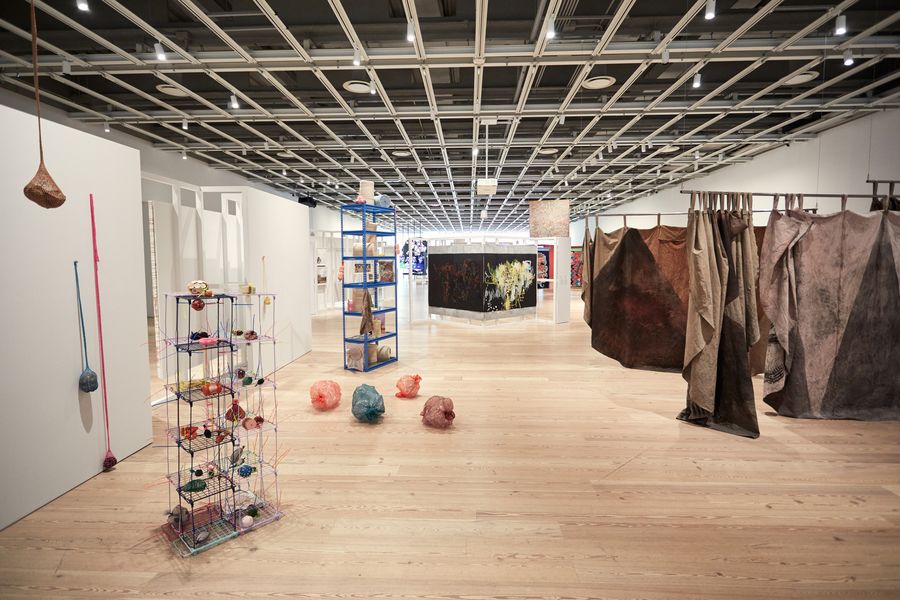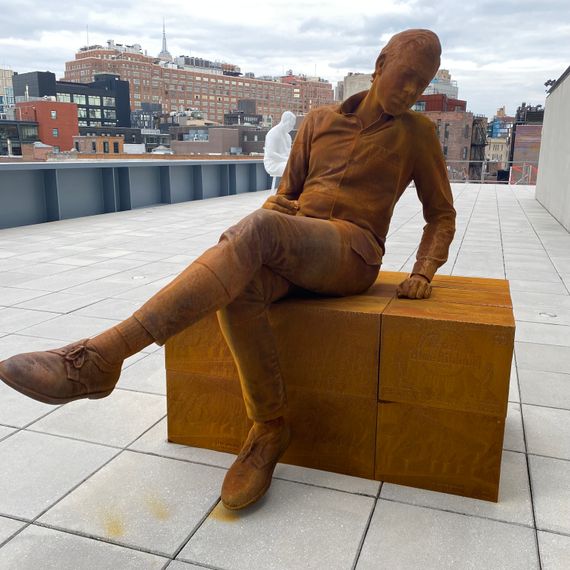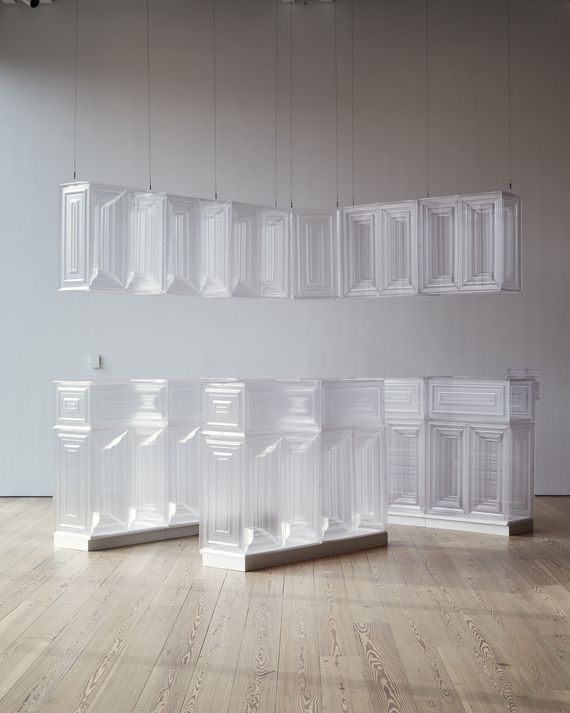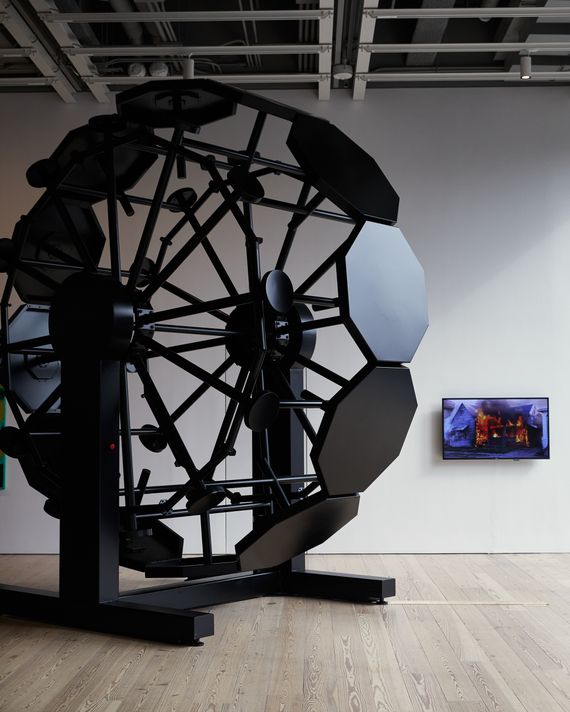This article was featured in One Great Story, New York’s reading recommendation newsletter. Sign up here to get it nightly.
About 20 percent of the 2022 Whitney Biennial is really alive. That’s passably high for one of these cattle calls. For all its irritations and flaws, “Quiet As It’s Kept,” as this show is called, is the best Biennial in some time. There’s very little here that’s really bad. Too much that’s mild. Give things that strike you as boring time and they get better. Plus it’s great to have the Biennial back — to talk about, to love and hate — after it was postponed a year because of the pandemic. Seeing one another and touching antennae again in the flesh feels more important and pleasurable than ever. The Biennial has always trafficked in the contemporary, but this year’s offering, even with the inclusion of deceased artists, radiates with the power of now.
The star of the show may be the space. Walking through the rampantly filled fifth floor is like drifting distracted through a spice market of art. We wander, peck, and pass on to the next display. It’s a swap meet of unlike items, a rejoinder to minimalism. An abundance of abstract painting — some of it very strong — lends much-needed gusts of color that exhibitions like this often lack. This light-filled limbo, with its serpentine structure, very much expresses what these past few years have felt like, their deep content: a strange neverland of surprising things coming around the next bend.
The sixth floor reflects our collective trip into the underworld, echoing the fear and isolation that took hold in the era of COVID-19 and white ethno-nationalism. It is dark, filled with alcoves, bottlenecks, and ceiling installations that make the world topsy-turvy. Some of it feels dated, the dying remnants of a contrived postmodern fracturing. There are long wall labels projecting meanings that are not actually in the work. This art is predicated on the idea that if the cause or subject matter of a work of art is good, then the work itself is good. If you don’t like the art, you’re seen as hostile to the cause. (I’ve been called pro-climate-change!) But the causes aren’t the problem; it’s the generic way these artists treat them.
For better and worse, Quiet As It’s Kept is a black mirror of our times. Two telling exclusions complicate things, however.
The diligent curators David Breslin and Adrienne Edwards omit what may be the most impactful video made in the 21st century. This is the ten-minute-nine-second continuous sequence made by 17-year-old Darnella Frazier of Derek Chauvin killing George Floyd. There is a powerful precedent for its inclusion: George Holliday’s recording of the beating of Rodney King was a cornerstone of the 1993 Biennial, a show the curators praise. Breslin and Edwards also had good reasons not to show the Floyd video again, out of respect for viewers who have seen one too many images of violence against Black people circulating online and for Floyd himself.
But the video does seem like an unexamined influence for much of the show. The irony of this omission is that the best work in the current Biennial is not derived from postmodern theorizing or academically approved post-conceptualism but founded on the tenets offered in Frazier video. That is, images and objects speak for themselves and can blast through doubt, paranoia, dogma, insularity, and art-world irony. This work is rooted in the premodern idea that art is a primary tool for exploring consciousness, putting us in contact with grief, memories, and precincts beyond the human sun of our reason. This is art as testimony and witnessing, participating both in its own time and in a historical continuum. The past few years have seen art turning in that direction.
Which brings us to the other exclusion. There have been scads of bad figurative painting lately that seem to want to make the world safe for portraiture. Amid the dross is a generation of artists of color who have jump-started something magnificent. None are included in this show. Artists such as Salman Toor (who had a strong 2020 show at the Whitney), Amy Sherald (who accomplished the impossible in her 2018 portrait of First Lady Michelle Obama), Winfred Rembert (who died last year, having survived incarceration following a lynching and castration attempt), Jonathan Lyndon Chase, Mickalene Thomas, Nina Chanel Abney, Jordan Casteel, and the preternaturally talented and influential late Noah Davis, as well as Njideka Akunyili-Crosby, Toyin Ojih Odutola, Leilah Babirye, and Reverend Joyce McDonald. These artists center people and places rarely seen in western art, reclaim the African influences coopted by modernism, and remix the canon in ways that are difficult to parse, and not just for the usual white viewer.
These snubs are doubly curious because the demographics of this Biennial are exemplary. Of the 59 individual artists in the show, 16 were born outside the United States. Thanks to the Amazonification of the art world — which has become an aesthetic fulfillment center awash in money from the best and worst of places — more art has been made, shown, and sold by more artists coming from more places than at any point in history. These very much include artists from previously underrepresented communities, the first inklings of a possible end to art-world apartheid. Have certain artists been shunned for making it on the market? I thought minority artists having success was part of what all this is about.
As a way of honoring the past, almost a quarter of the artists have been in previous Biennials. Several of their works stand out, including Coco Fusco’s dreamy film featuring a cemetery island in the waters of New York and Ellen Gallagher’s tomblike paintings made with oil, pigment, palladium leaf, and paper on canvas. Best in this subcategory are Charles Ray’s three figurative sculptures made of steel or painted bronze of ordinary men sitting on stools and blocks. Oversize and brooding, they exude an otherness that changes the gravitational fields around them. I could write a whole review of these men.
Of those making their Biennial debut, there are some powerful examples of artist priestcraft. Emily Barker creates a translucent kitchen with a countertop set five feet nine inches high, which is the average height of an American man, making the cabinets almost out of reach. This surrealist displacement transforms into a living nightmare when you learn that Barker uses a wheelchair, and this is how they experience their environment 24/7. Nearby is a stack of 7,865 sheets of bills from one year of their spinal-cord-injury and chronic-pain management. It is bureaucracy and callousness made visible.
Another sort of system is made visible in Rose Salane’s mad Smaug’s treasure 64,000 Attempts at Circulation, consisting of hills of counterfeit coins, tokens, foreign currencies, casino chips, and other souvenirs many of us used to use to get on the bus — a Darwinian testament to the adaptive ways we get by in the city. Three Songs, Raven Chacon’s solo Biennial debut, is a series of gorgeous videos of American Indian women singing “songs of resistance,” accompanied by a solitary snare drum that hits you with the force of hieroglyphics. Lucy Raven’s video installation of beautiful southwestern landscapes followed by muffled explosions shook me. Jonathan Berger’s charcoal-floored room is like a chapel, decorated with screens of metallic letters spelling out visionary texts, making you feel as if you’re deciphering the secret languages of God.
Rayyane Tabet’s texts, installed throughout the museum in fragments and on the façade in large letters, freaked me out. These are questions the Lebanon-born artist encountered in anticipation of taking his U.S. naturalization test, maddeningly impossible queries like “What is the rule of law?” and “What is one promise you make when you become a United States citizen?” There’s a crazy-good David Hammons installation that is part of the re-creation of the library in the late Steve Cannon’s legendary East Village salon A Gathering of the Tribes, including a replica of the couch where one used to sit and talk with Cannon. I loved Alex Da Corte’s installation even if it does include an overly obvious art-historical reference to Marcel Duchamp drinking one of Jasper Johns’s Ballantine ale cans.
Near the loading docks, almost begging to be missed and standing apart from the Biennial’s heaven-and-hell bifurcation of our present moment, is Nayland Blake’s simulacrum of the entry of the legendary BDSM leather sex club Mineshaft — once located a block or so from where the Whitney now stands. It’s a black wall featuring two white arrows with the words “private club” and “members only,” pointing to a red industrial door with an empty awning. It may not be a great work of art, but it is a mystical gate. Blake rubs the side of the museum like a magic lantern, conjuring the lost desires of the lovers, losers, and holy spirits in search of their city of dreams, those who did it for lust and ran with the night. Close your eyes and glean the glory and horror of the years between 1976 and 1985, by which time the Mineshaft had closed, AIDS was raging, and the entire world came down like a ton of bricks on places like these and those who frequented them.
I see myself in those years, a truck driver without a driver’s license working night shifts just blocks away next to the Hellfire Club, another sex bar. I discern ghosts, summoned as if by some inner tide: people milling in darkened streets, cars cruising, sex in the shadows. On hot summer nights, it was like a city of shades that had crossed the Red Sea, an exodus looking for redemption and ecstasy. I see David Wojnarowicz, who famously installed art in a pier along the Hudson. Before AIDS took his life, he wrote about “daydreams of tipping amazonian blowdarts in ‘infected blood’ and spitting them at the exposed necklines of certain politicians or nazi-preachers” and imagining friends of AIDS victims dumping their corpses on the front steps of the White House.
Here are demons and angels and the smell of sex and fear of contagion. But also liberation and something immense that refused to keep quiet, that wouldn’t be denied and left for dead even though so many, then as now, were dying. Here we glimpse vision, poetry, freedom, courage, and an angry bile duct — a termite mound of new ideas and beauty.
Want more stories like this one? Subscribe now to support our journalism and get unlimited access to our coverage. If you prefer to read in print, you can also find this article in the April 11, 2022, issue of New York Magazine.
Related
- What to See and What to Skip at the Whitney Biennial
- A True Protest Biennial
- Whitney Biennial Artists Share Mood Boards for Their Works






